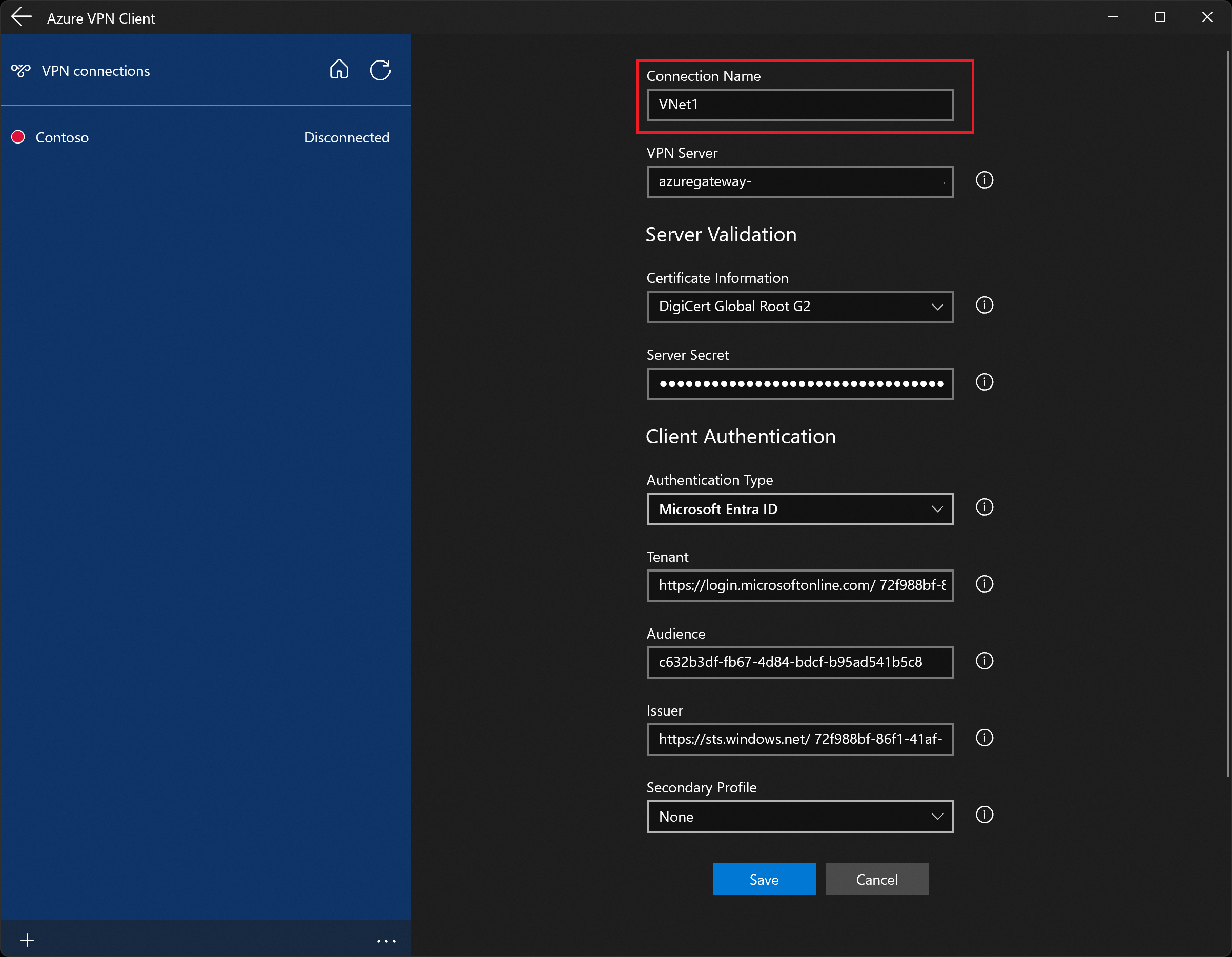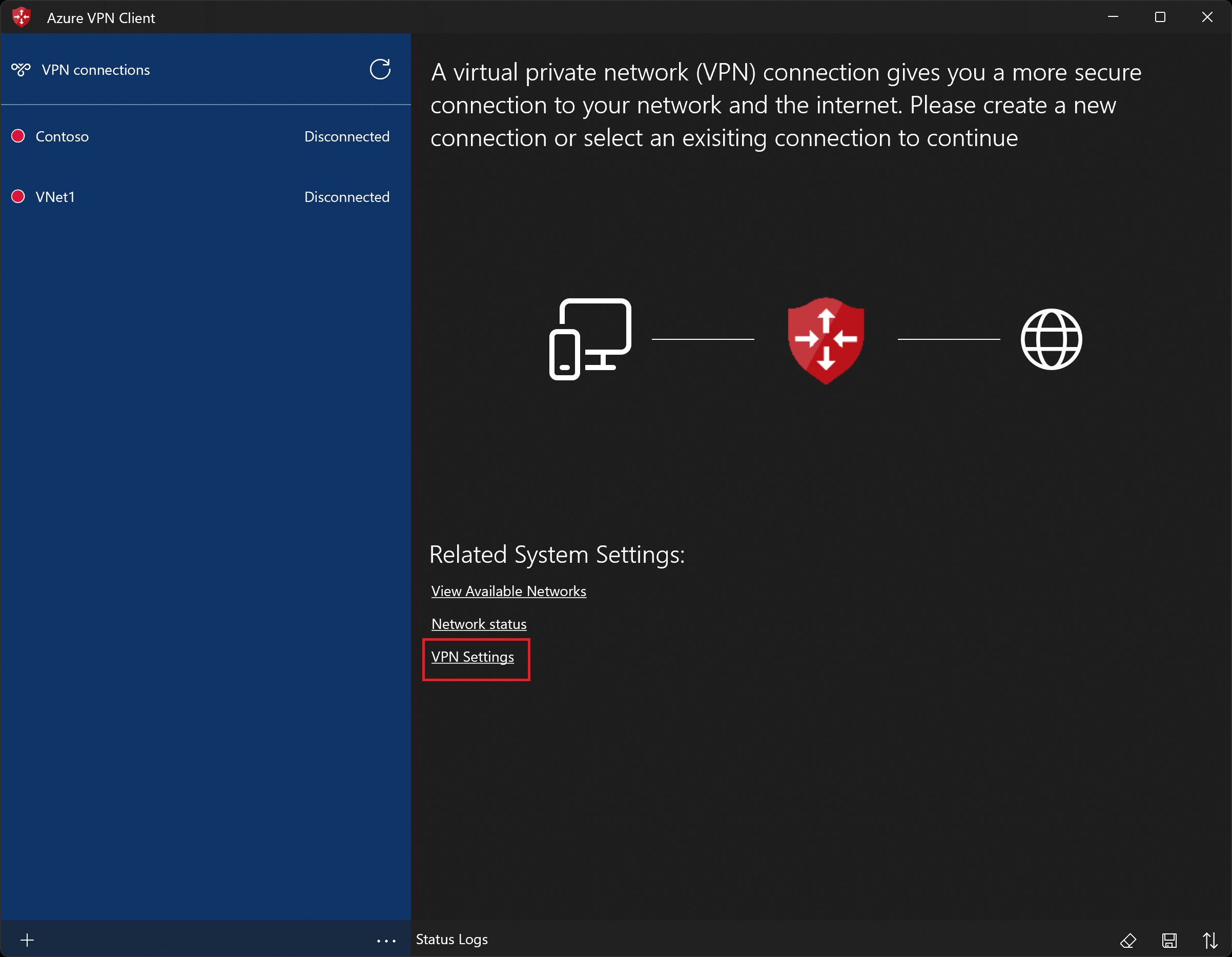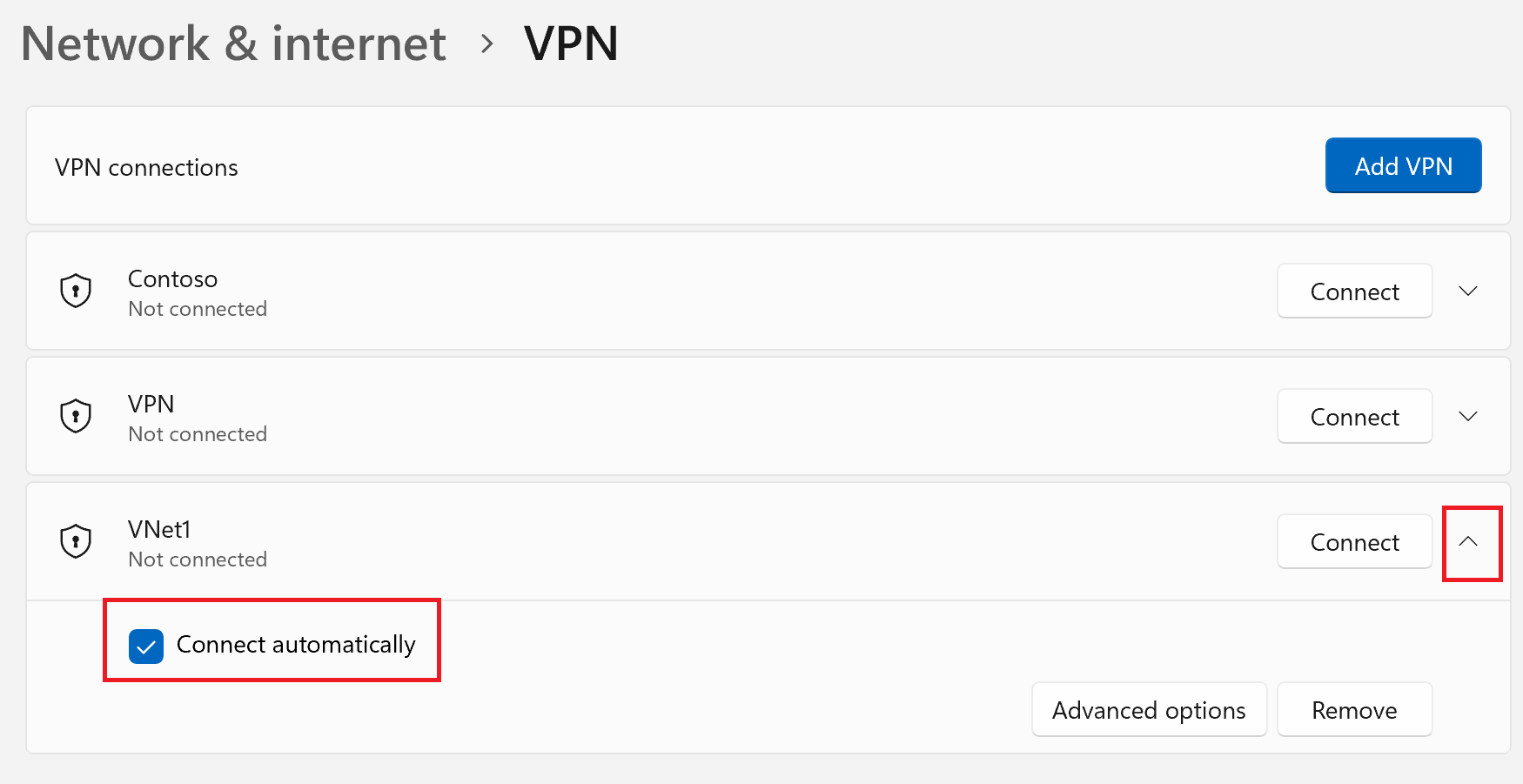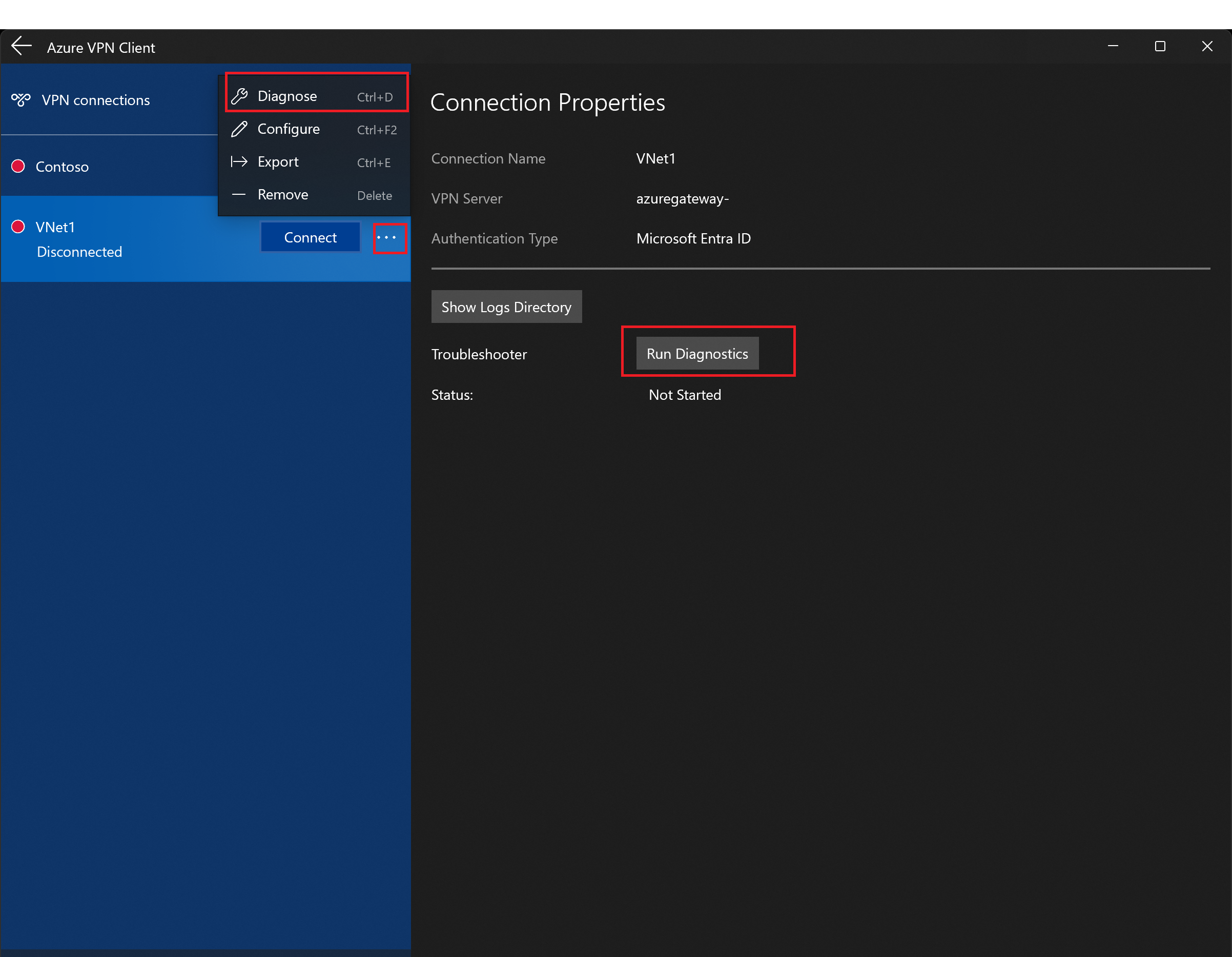Configure Azure VPN Client – Microsoft Entra ID authentication – Windows
This article helps you configure the Azure VPN Client on a Windows computer to connect to a virtual network using a VPN Gateway point-to-site (P2S) VPN and Microsoft Entra ID authentication. For more information about point-to-site connections, see About point-to-site connections. The Azure VPN Client is supported with Windows FIPS mode by using the KB4577063 hotfix.
Prerequisites
Configure your VPN gateway for point-to-site VPN connections that specify Microsoft Entra ID authentication. See Configure a P2S VPN gateway for Microsoft Entra ID authentication.
Workflow
This article continues on from the Configure a P2S VPN gateway for Microsoft Entra ID authentication steps. This article helps you:
- Download and install the Azure VPN Client for Windows.
- Extract the VPN client profile configuration files.
- Update the profile configuration files with a custom audience value (if applicable).
- Import the client profile settings to the VPN client.
- Create a connection and connect to Azure.
Download the Azure VPN Client
Download the latest version of the Azure VPN Client install files using one of the following links:
- Install using Client Install files: https://aka.ms/azvpnclientdownload.
- Install directly, when signed in on a client computer: Microsoft Store.
Install the Azure VPN Client to each computer.
Verify that the Azure VPN Client has permission to run in the background. For steps, see Windows background apps.
To verify the installed client version, open the Azure VPN Client. Go to the bottom of the client and click ... -> ? Help. In the right pane, you can see the client version number.
Extract client profile configuration files
To configure your Azure VPN Client profile, you must first download the VPN client profile configuration package from the Azure P2S gateway. This package is specific to the configured VPN gateway and contains the necessary settings to configure the VPN client. If you used the P2S server configuration steps as mentioned in the Prerequisites section, you've already generated and downloaded the VPN client profile configuration package that contains the VPN profile configuration files. If you need to generate configuration files, see Download the VPN client profile configuration package.
After you obtain the VPN client profile configuration package, extract the zip file. The zip file contains the AzureVPN folder. The AzureVPN folder contains the azurevpnconfig_aad.xml file or the azurevpnconfig.xml file, depending on whether your P2S configuration includes multiple authentication types. If you don't see azurevpnconfig_aad.xml or azurevpnconfig.xml, or you don't have an AzureVPN folder, verify that your VPN gateway is configured to use the OpenVPN tunnel type and that Azure Active Directory (Microsoft Entra ID) authentication is selected.
Modify profile configuration files
If your P2S configuration uses a custom audience with your Microsoft-registered App ID, you might receive popups each time you connect that require you to enter your credentials again and complete authentication. Retrying authentication usually resolves the issue. This happens because the VPN client profile needs both the custom audience ID, and the Microsoft application ID. To prevent this, modify your profile configuration .xml file to include both the custom application ID and the Microsoft application ID.
Note
This step is necessary for P2S gateway configurations that use a custom audience value and your registered app is associated with the Microsoft-registered Azure VPN Client app ID. If this doesn't apply to your P2S gateway configuration, you can skip this step.
To modify the Azure VPN Client configuration .xml file, open the file using a text editor such as Notepad.
Next, add the value for
applicationidand save your changes. The following example shows the application ID valuec632b3df-fb67-4d84-bdcf-b95ad541b5c8.Example
<aad> <audience>{customAudienceID}</audience> <issuer>https://sts.windows.net/{tenant ID value}/</issuer> <tenant>https://login.microsoftonline.com/{tenant ID value}/</tenant> <applicationid>c632b3df-fb67-4d84-bdcf-b95ad541b5c8</applicationid> </aad>
Import client profile configuration settings
Note
We're in the process of changing the Azure VPN Client fields for Azure Active Directory to Microsoft Entra ID. If you see Microsoft Entra ID fields referenced in this article, but don't yet see those values reflected in the client, select the comparable Azure Active Directory values.
Open the Azure VPN Client.
Select + on the bottom left of the page, then select Import.
Browse to the Azure VPN Client profile configuration folder that you extracted. Open the AzureVPN folder and select the client profile configuration file (azurevpnconfig_aad.xml or azurevpnconfig.xml). Select Open to import the file.
On the client profile page, notice that many of the settings are already specified. The preconfigured settings are contained in the VPN client profile package that you imported. Even though most of the settings are already specified, you need to configure settings specific to the client computer.
Change the name of the Connection name (optional). In this example, notice that the Audience value shown is the value that's associated to the Microsoft-registered Azure VPN Client App ID. The value in this field must match the value that your P2S VPN gateway is configured to use.
Click Save to save the connection profile.
In the left pane, select the connection profile that you want to use. Then click Connect to initiate the connection.
Authenticate using your credentials, if prompted.
Once connected, the icon turns green and shows Connected.
To connect automatically
These steps help you configure your connection to connect automatically with Always-on.
On the home page for your VPN client, select VPN Settings. If you see the switch apps dialogue box, select Yes.
If the profile that you want to configure is connected, disconnect the connection, then highlight the profile and select the Connect automatically check box.
Select Connect to initiate the VPN connection.
Export and distribute a client profile
Once you have a working profile and need to distribute it to other users, you can export it using the following steps:
Highlight the VPN client profile that you want to export, select the ..., then select Export.
Select the location that you want to save this profile to, leave the file name as is, then select Save to save the xml file.
Delete a client profile
Highlight the VPN client profile that you want to export, select the ..., then select Remove.
On the confirmation popup, select Remove to delete.
Diagnose connection issues
Optional client configuration settings
You can configure the Azure VPN Client with optional configuration settings such as additional DNS servers, custom DNS, forced tunneling, custom routes, and other settings. For more information, see Azure VPN Client - optional settings.
Azure VPN Client version information
For Azure VPN Client version information, see Azure VPN Client versions.




